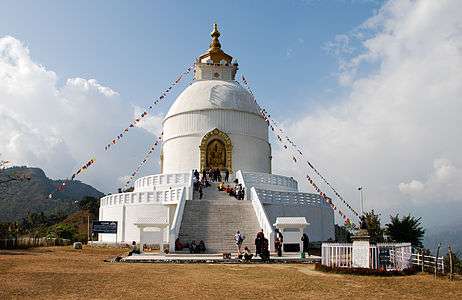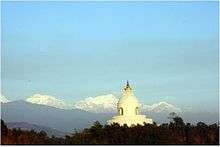Shanti Stupa, Pokhara

Pokhara Shanti Stupa is a Buddhist pagoda-style monument on a hilltop in Ananda hill of the former Pumdi Bhumdi Village Development Committee, in the district of Kaski, Nepal[1] (now a part of the city of Pokhara).
Shanti Stupa in Pokhara was built by Nipponzan-Myōhōji monk Morioka Sonin with local supporters under the guidance of Nichidatsu Fujii, a Buddhist monk and the founder of Nipponzan-Myōhōji. Shanti is a Sanskrit word meaning peace, also widely used in Nepali and Hindi language, and Shanti Stupa means Peace Pagoda. Shanti Stupa is the shrine build as symbol of peace. The spot situated at the height of 1100 meters on the Ananda Hill was chosen by Nichidatsu Fujii and he laid the foundation stone as well with the relics of Buddha on the hilltop on 12 September 1973.[1][2] Nepal has two of the eighty peace pagodas in the world: Shanti Stupa in Lumbini, the birthplace of Buddha and Shanti Stupa in Pokhara. Shanti Stupa in Pokhara has also become a tourist attraction. It provides a panoramic view of the Annapurna range, Pokhara city and the Fewa Lake.[3]

Construction
Nichidatsu Fujii planned to construct Peace Pagodas in 1947, in many locations around the world as a symbol of world peace.[4] Nipponzan-Myōhōji and locals of Pokhara built Shanti Stupa. Morioka Sonin, Dharmashilla Guruma (nun) and Min Bahadur Gurung were the key people in constructing the pagoda. During the construction of Shanti Stupa, Nepal government had arrested them several time with false accusations.[2] Morioka Sonin took the initiative of building the Shanti Stupa in Pokhara. Dharmashilla Guruma of Dhamashilla Buddha Bihar, Pokhara was very positive about the proposal from Nipponzan-Myōhōji and was involved in creating active participation from the locals in Pokhara. The statue of first elected deputy defense minister Min Bahadur Gurung,congress party member is placed in front of the Shanti Stupa to honor his role in building the hilltop monument by donating the land.[1] On 28 November 1973, the prayer hall with the statue of Buddha and the Guest House was set up. When the construction of the pagoda had reached 35 feet, Panchayati and Royal Nepal government requested to the concerned party to destroy the pagoda and the buildings showing town-planning and security reasons.[2] The building was not officially "passed" by the local government. Even though building the pagoda was off-limits, with the continuous support from Nipponzan-Myōhōji, the supporters and the monks were constantly working to rebuild the pagoda. Nichidatsu Fujii had prophesized that one day the Shanti Stupa would be rebuilt. On 21 May 1992, after 18 years of uphill battle, Honorable late Girija Prasad Koirala by his own interest came to the Anadu hill and re-laid the foundation stone. Then construction work was completed without obstruction and inaugural ceremony was conducted in the presence of Chairman of Nepali Congress Party and the former Prime Minister Girija Prasad Koirala on 30 October 1999.[2]

Description and significance
Shanti Stupa in Pokhara is the first World Peace Pagoda in Nepal and seventy-first pagoda built by Nipponzan-Myōhōji in the world. The pagoda is 115 feet tall and 344 feet in diameter. The white pagoda has two tiers for tourist and religious people to circumambulate.[1] Second tier displays the four statues of Buddha presented as a souvenirs from different countries: ‘Dharmacakra Mudra’ from Japan, ‘Bodh Gaya’ from Sri Lanka, ‘Kushinagar’ from Thailand and 'Lumbini’ from Nepal. Each statues represents the important events related to Buddha and named according to the place where it took place.[1][5] Dharmachakra is placed below gajur (pinnacle) which signifies wheel of life, dharma and Buddha’s teaching. Top of the golden gajur holds the crystal stone from Sri Lanka which symbolizes intellect and grace.[1] Dhamma hall with Buddha statue is located nearby the peace pagoda where Buddhist rituals take place daily and big ceremonies pujas are performed on the important dates according to Lunar calendar, such as on full moon day.[6]

Tourist attraction
Standing on top of the Ananda hill, Shanti Stupa adds more beauty to Pokhara Valley. It is a perfect holiday place providing a clear view of the Himalayan range, Fewa Lake and Pokhara city. The hilltop provides a splendid view of sunrise and sunset. TripAdvisor has ranked Shanti Stupa as top second attraction in Pokhara.[7] The pagoda is 7 kilometers from Mahendrapool, the major business spot in Pokhara. There are several ways to reach the peace pagoda. There are hiking trails, cycling tracks and the blacked topped road to the Stupa.[1] There are many trails for hiking. One of the popular and adventurous hiking trails is by crossing the Fewa Lake by a local boat and climb uphill through the local villages that takes about an hour to reach the hilltop. There have been cases of mugging in the hiking trails in previous years. The partial black-topped road from Chorepatan to the Stupa takes about 25 minutes, which can be reached by taxi or private cars. There is no public transports yet available to the foothill of the Stupa.[5]
See also
| Wikimedia Commons has media related to Pokhara Shanti Stupa. |
References
- 1 2 3 4 5 6 7 Sulochana Bamanu. "Shanti Stupa(Pokhara)". educatesansar.com. Retrieved 18 April 2013.
- 1 2 3 4 "World Peace Pagoda - Pokhara Nepal.". Retrieved 19 April 2013.
- ↑ "Pokhara". http://www.sacredsites.com. Retrieved 22 April 2013. External link in
|publisher=(help) - ↑ Queen, Christopher S (2000). Engaged Buddhism in the West. Wisdom Publications, US. ISBN 978-0-86171-159-8.
- 1 2 Kauba, Pat. "Up & Over to The World Peace Pagoda". www.ecs.com.np. Retrieved 19 April 2013.
- ↑ भण्डारी, कृपा (30 April 2012). "सप्ताहब्यापी रुम्पमा बुद्ध जयन्ती आजबाट सुरु, टुडिखेलबाट विश्वशान्ति स्तुप सम्म शुभारम्भ र्याली". Pokhara Today. Retrieved 19 April 2013.
- ↑ "Peace Temple: Traveler Reviews". www.tripadvisor.com. Retrieved 19 April 2013.